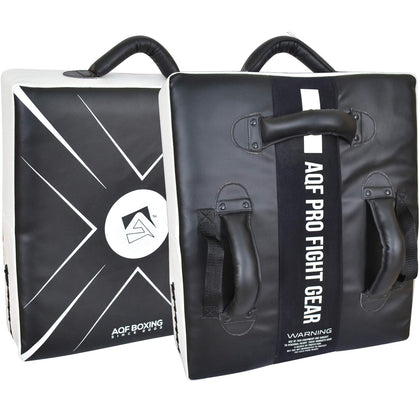25+ Muay Thai Combos for All Skill Levels

Powerful and graceful Muay Thai combos perfectly display ancient martial art principles. The well-calculated strikes, footwork, and strategic moves during Muay Thai matches captivate Muay Thai enthusiasts like you. However, executing Muay Thai combos is harder than it looks. The combos, strikes, and footwork might seem challenging initially, but you can build the skill with some practice.
This guide has curated essential Muay Thai combos, practice techniques, and expert tips to help you master Muay Thai like a pro.
Get ready to unleash your inner warrior and learn the fundamentals of Muay Thai combos in a friendly and easy-to-follow format. Let’s dive in and discover the thrilling world of Muay Thai together!
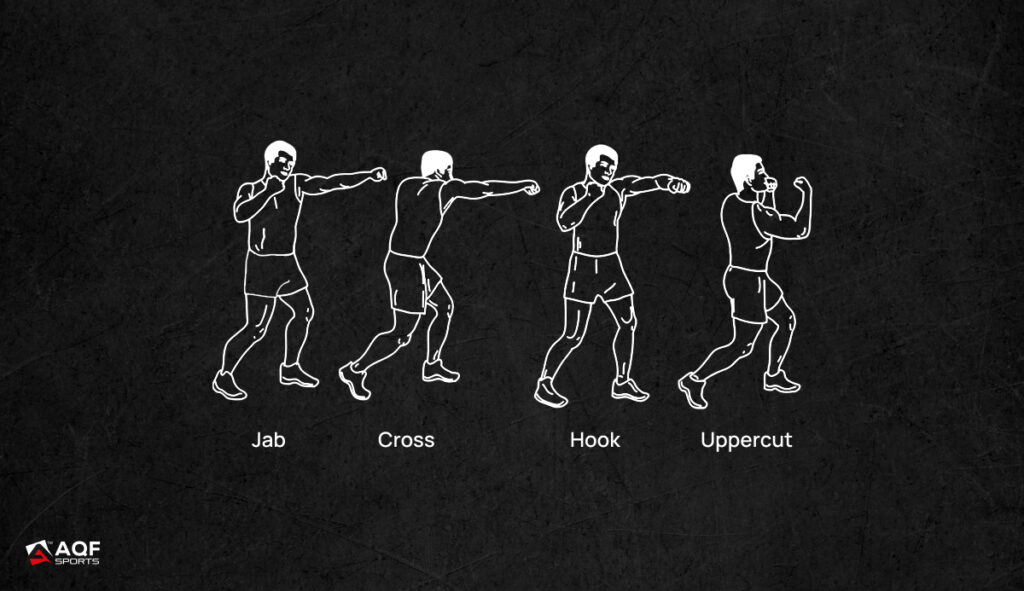
Basic Muay Thai Combos
- Ideal for beginners to learn and build fundamental striking skills.
- Used to establish the basics of combination punching and kicking techniques.
- Effective for developing coordination and timing.
Jab-Cross (1-2)
Throw a quick jab with your lead hand (usually your left), followed by a strong cross with your rear hand (usually your right). Aim for your opponent’s face or upper body with each punch.
Lead Hook-Rear Cross (3-2)
Start with a hook punch from your lead hand, targeting the side of your opponent’s head or body. Follow it up with a powerful cross punch to their face or upper body.
Jab-Cross-Hook (1-2-3)
Begin with a jab to your opponent’s face or upper body, then follow up with a cross to the same target area. Finally, deliver a hook punch to the side of their head or body.
Teep (Front Kick)-Cross (Kick)-Lead Hook (Push Kick-2-3)
Push your opponent away with a front kick (teep) at their midsection or chest. Follow it up with a cross kick using your rear leg, and then finish with a lead hook punch to their face or body.
Low Kick-Cross-Hook (Kick-2-3)
Aim a low kick at your opponent’s lead leg, targeting their thigh. Follow it up with a powerful cross punch to their face or upper body, then deliver a hook punch to the side of their head or body.
Parry-Cross-Hook-Clinch (Parry-2-3-Clinch)
Defend against your opponent’s punch by using a parry technique. Then, counter with a cross punch to their face or upper body, followed by a hook punch to the side of their head or body. Afterward, quickly close the distance to initiate a clinch to control their movements.
Cross-Hook-Elbow (2-3-Elbow)
Start with a strong cross punch to your opponent’s face or upper body, then quickly follow up with a hook punch to the side of their head or body. Finally, unleash a powerful elbow strike to their face or body from close range.
Further Reading: How to Punch Harder? Mistakes to Avoid & Tips to Follow

Intermediate Muay Thai Combos
- Suitable for practitioners with some experience in Muay Thai.
- Used to expand the variety of techniques in combinations.
- Effective for setting up more complex attacks and creating openings in the opponent’s defense.
Jab-Teep-Rear Knee (1-Teep-9):
Start with a jab to your opponent’s face or upper body, then use a front kick (teep) to create distance. Follow it up by delivering a powerful knee strike with your rear leg to their midsection or thighs.
Lead Hook-Rear Kick-Cross (3-Kick-2):
Throw a lead hook punch to the side of your opponent’s head or body. Quickly transition to a powerful rear leg kick targeting their thigh or midsection. Finish the combo with a strong cross punch to their face or upper body.
Lead Uppercut-Rear Hook-Clinch (4-3-Clinch):
Begin with a lead uppercut punch to your opponent’s chin or body. Follow it up with a rear hook punch to the side of their head or body. Then, close the distance and enter a clinch to control their movements.
Jab-Cross-Teep (1-2-Teep):
Start with a jab to your opponent’s face or upper body, then follow up with a cross to the same target area. Afterward, push the opponent back with a front kick (teep) aimed at their midsection or chest.
Advanced Muay Thai Combos
- Suitable for experienced and skilled Muay Thai fighters.
- Utilized to demonstrate a high level of technical proficiency and tactical understanding.
- Effective for surprising opponents with unique and sophisticated combinations.
Jab-Cross-Hook-Elbow (1-2-3-Elbow):
Throw a jab to your opponent’s face or upper body, quickly followed by a cross punch to the same target area. Continue the combo with a hook punch to the side of their head or body. Finally, unleash a devastating elbow strike to their face or body from close range.
Read More: How to Punch Faster: Boxing Hand Speed Drills and Tips
Lead Teep-Rear Knee-Switch Kick-Cross (Teep-9-Switch Kick-2):
Start with a lead front kick (teep) to your opponent’s midsection or chest, then transition smoothly into a rear knee strike targeting their midsection or thighs. Next, switch stance and deliver a strong kick to their head. Finish with a powerful cross punch to their face or upper body.
Lead Hook-Rear Elbow-Parry-Clinch (3-Elbow-Parry-Clinch):
Throw a lead hook punch to the side of your opponent’s head or body, then quickly transition to a rear elbow strike from close range. Next, use a parry technique to defend against their counter and immediately enter a clinch to control their movements.
Fake Kick-Cross-Hook-Low Kick (Fake Kick-2-3-Kick):
Feint a kick to get your opponent to react, then capitalize on their movement by delivering a cross punch to their face or upper body. Follow it up with a hook punch to the side of their head or body, then conclude with a low kick to their leg or body.
Muay Thai Fake Kick Combos
- Ideal for deceiving and confusing opponents.
- Used to create openings by drawing reactions from the opponent.
- Effective for setting up powerful follow-up strikes after the opponent reacts to the feinted kick.
Fake Kick + Cross + Hook + Low Kick (Fake Kick-2-3-Kick):
Instructions: Feint a kick to make the opponent react. Then quickly follow up with a cross punch to their face or upper body. Next, deliver a hook punch to the side of their head or body. Finally, conclude the combo with a low kick to their leg or body.
Muay Thai Combination Setups
- Ideal for strategically planning future attacks.
- Used to gauge the opponent’s reactions and adjust the strategy accordingly.
- Effective for preparing the opponent for a specific technique or combo.
Jab + Double Jab + Cross + Leg Kick
Instructions: Start with a jab to the opponent’s face or upper body. Follow it up with two quick jabs to create a setup. Then, unleash a powerful cross punch to their face or upper body. Finally, finish the combo with a leg kick targeting their thigh or lower body.
Jab + Double Jab + Cross + Teep
Instructions: Start with a jab to the opponent’s face or upper body. Follow it up with two quick jabs to set up the combo. Then, deliver a strong cross punch to their face or upper body. Finally, push the opponent back with a front kick (teep) to their midsection or chest.
Muay Thai Counter Combos
- Ideal for countering an opponent’s attacks.
- Used to capitalize on the opponent’s openings after evading or blocking their strikes.
- Effective for turning defensive maneuvers into immediate offensive opportunities.
Jab + Cross + Left Hook (Counter Combo)
Instructions: In response to an opponent’s attack, quickly counter with a jab to their face or upper body, followed by a cross punch. Then, conclude the combo with a left hook punch to the side of their head or body.
Sub-types:
Lead Teep + Cross + Left Elbow (Counter Combo)
Instructions: As the opponent moves in, use a lead front kick (teep) to push them back. Follow it up with a cross punch to their face or upper body. Finally, deliver a powerful left elbow strike from close range.
Muay Thai Clinch Combos
- Ideal for fighters who excel in close-quarters fighting and clinching.
- Used to transition from striking range to clinch range seamlessly.
- Effective for inflicting damage with knees and elbows from the clinch position.
Jab + Cross + Left Hook + [Right] Knee Strike (Clinch Combo)
Instructions: Execute a jab to the opponent’s face or upper body, then quickly follow up with a cross punch. Next, deliver a left hook to the side of their head or body. Now, close the distance and initiate a clinch. Finally, deliver a powerful knee strike with your right knee.
Jab + Cross + [Left] Knee Strike + Sweep Takedown (Clinch Combo)
Instructions: Start with a jab to the opponent’s face or upper body, then quickly follow up with a cross punch. Next, deliver a knee strike with your left knee. Now, use your clinch position to sweep the opponent’s leg and take them down.
Muay Thai Defensive Combos
- Ideal for fighters who prefer a defensive and counterattacking style.
- Used to evade, deflect, or block the opponent’s attacks while immediately countering.
- Effective for staying defensively sound while inflicting damage.
Parry + Cross + Hook + Slip + Counter Cross
Instructions: Defend against the opponent’s punch with a parry technique. Then, counter with a cross punch to their face or upper body, followed by a hook punch to the side of their head or body. Next, slip to the side to evade a potential counterattack. Finally, respond with a counter-cross punch.
Slip + Left Hook + Cross + [Right] Uppercut (Defensive Combo)
Instructions: Slip to the outside to evade the opponent’s punch. Immediately counter with a left hook to the side of their head or body, followed by a cross punch to their face or upper body. Finish with a powerful right uppercut to their chin.
Muay Thai Low Kick Combos
- Ideal for slowing down opponents and weakening their legs.
- Used to target the opponent’s lower body and compromise their mobility.
- Effective for disrupting the opponent’s balance and limiting their ability to strike effectively.
Jab + Cross + [Left] Leg Kick
Instructions: Start with a jab to the opponent’s face or upper body, then quickly follow up with a cross punch. Finally, conclude the combo with a low kick targeting their lead leg or thigh.
Fake Low Kick + Cross + Low Kick (Low Kick Combo)
Instructions: Feint a low kick to make the opponent react. Then quickly follow up with a cross punch to their face or upper body. Finally, execute a low kick to their leg or body.
Muay Thai Head Kick Combos
- Ideal for fighters with strong kicking abilities.
- Used to deliver powerful kicks to the opponent’s head and knock them out
- Effective for catching opponents off guard and finishing fights with a well-placed head kick.
[Left] Head Kick + Cross to the Body + [Left] Hook to the Body + [Right] Head Kick
Instructions: Execute a left head kick aimed at the opponent’s head, then quickly transition to a cross punch to their body. Follow it up with a left hook to their body. Finally, unleash a powerful right head kick to their head.
Sub-types:
[Right] Head Kick + Cross + Switch Kick to the Body (Head Kick Combo)
Instructions: Launch a powerful right head kick targeting the opponent’s head. Then, quickly follow up with a cross punch to their face or upper body. Finally, switch your stance and deliver a powerful kick to your body.
Muay Thai Switch Kick Combos
Muay Thai Switch Kick Combos are used to surprise opponents by swiftly changing their stance and angles of attack. This catches your opponent off guard and gives you more opportunities for strikes.
[Left] Head Kick + Cross + Switch Kick to the Body (Switch Kick Combo)
Instructions: Launch a powerful left-head kick targeting the opponent’s head. Then, quickly follow up with a cross punch to their face or upper body. Finally, switch your stance and deliver a powerful kick to your body.
Tips to Expertly Execute Muay Thai Combos During the Match
- Master the Basics: Focus on refining your stance, footwork, and fundamental techniques (jab, cross, hook, kick, knee).
- Timing and Rhythm: Vary the speed of your strikes to keep opponents off-balance and find openings.
- Footwork and Angles: Train in footwork drills for quick movement and utilize angles to attack from unexpected directions.
- Setups and Feints: Test opponents with feints before executing combos to create openings.
- Read the Opponent: Analyze the opponent’s tendencies during training and adjust combos based on their reactions.
- Conditioning and Endurance: Regularly incorporate high-intensity interval training (HIIT) and shadow box combos for better endurance.
- Target Selection: Try different combos to target the head, body, and legs, exploiting the opponent’s vulnerabilities.
- Flow and Transitions: The chain strikes smoothly for continuous combo flow and focuses on footwork during transitions.
- Control and Defense: Regain stance quickly after combos and keep guard for better defense.
- Sparring and Drills: Spar with partners of varying skill levels and drill combos with accuracy, speed, and technique.
- Be Mentally Prepared: Stay composed and confident to influence opponents during the match.
- Stick to the Game Plan: Develop a strategic game plan and adapt combos based on the opponent’s strengths and weaknesses.
Muay Thai Pads and Kick shields
Muay Thai Pads:
Design: Thai pads are thick, rectangular pads usually made of foam or dense padding. They have handles on the back and straps that the holder wraps around their forearm to secure the pad.
Striking Surface: The front surface of the Thai pad is the target area for the fighter’s strikes. It provides a cushioned surface for punches, kicks, knees, and elbows.
Handling: The holder positions the Thai pad to match the height and angle of the fighter’s target, offering a realistic striking experience. The holder absorbs the impact of strikes, allowing the fighter to deliver powerful combos safely.
Mobility: Thai pads are versatile and easy to move around, allowing the holder to adjust the positioning quickly to simulate different striking angles and movements.
-
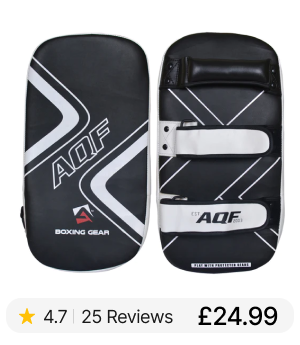
AQF Thai Pad
View Details -
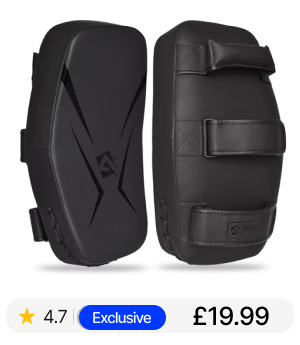
Muay Thai Training Pads
View Details -
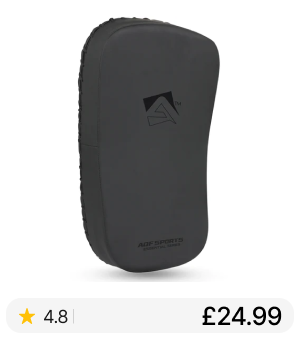
AQF Thai Pad – Essential Series
View Details
Kick Shields:
Design: Kick shields are siblings of Thai pads. They are thicker and provide more surface area than thai pads. They are typically made of dense foam with reinforced handles at the back.
Striking Surface: The front surface of the kick shield is the target area, designed specifically for kicks, knees, and other striking techniques.
Handling: The holder grips the handles at the back of the kick shield, ensuring a secure and stable grip during training. The kick shield provides resistance against the fighter’s strikes, helping them develop power and precision.
Specialization: Kick shields are particularly useful for honing kicking techniques. The holder can also adjust the angle of the kick shield to match the fighter’s technique and simulate various defensive scenarios.
Muay Combo Practice Technique Using Thai Pads and Kick shields
Instructions For the Holder (Trainer):
- Positioning: Stand comfortably with your feet shoulder-width apart and knees slightly bent. Hold the Thai pad or kick-shield with both hands securely in front of you.
- Grip: Grip the handles of the Thai pad or kick-shield firmly to maintain control during the training session.
- Communication: Before starting, communicate with the fighter about the specific combos or techniques you’ll be working on. Discuss the intensity level and ensure you are both on the same page.
- Target Area: Position the Thai pad or kick shield to match the fighter’s height and striking range. Adjust the target area according to the practiced technique (e.g., head, body, legs).
- Stability: Brace your core and maintain a stable base to absorb the impact of the fighter’s strikes. Ensure you’re balanced to prevent any unexpected movements.
- Feeding the Strikes: Give timely and controlled resistance as the fighter executes the combos. Allow them to flow between strikes, adjusting your positioning as needed.
- Feedback: Provide constructive feedback to the fighter during the training session. Point out areas for improvement and praise them for executing combos correctly.
Instructions For the Fighter:
- Focus and Control: Before starting, focus on the technique and maintain control over your strikes. Remember to breathe and stay composed during the session.
- Safety First: Train at a controlled pace to avoid injury to yourself and the holder. Never go all out unless agreed upon for specific drills.
- Technique Over Power: Focus on proper technique rather than power. Precision and accuracy are more important during training.
- Combination Flow: Execute the combos smoothly, flowing from one strike to the next. Pay attention to the timing and rhythm.
- Communication: If something feels off or uncomfortable, communicate with the holder immediately. Clear communication ensures a safe and beneficial training experience.
- Protect Yourself: Maintain your guard and protect your face during the training session, especially when delivering strikes.
- Listening to Feedback: Pay attention to the holder’s feedback and make necessary adjustments to improve your technique.

Things to Look for in Muay Thai Pads
- High-quality padding material for effective impact absorption and protection.
- Appropriate size and weight for a balanced and maneuverable training experience.
- Durable construction with reinforced stitching to ensure longevity.
- Comfortable handles and ergonomic straps for the holder’s convenience.
- Versatility to accommodate various techniques like punches, kicks, elbows, and knees.
Things to Look for in Kick shields

- Dense foam with ample resistance to develop power and strength.
- Size and shape suitable for effective kicking practice and targeting.
- Sturdy handles offer a secure grip for the holder during training.
- Optimal weight for easy mobility by the holder while providing enough resistance.
- Durable materials and construction to withstand repeated strikes.
The Bottomline
In conclusion, you can practice several Muay Thai combos to master this ancient art! We covered how to use Thai pads and kick shields effectively in training and sparring sessions.
Every strike you practice and every combo you master brings you one step closer to becoming a proficient Muay Thai warrior. Don’t let challenges discourage you, and stay committed to your progress.
